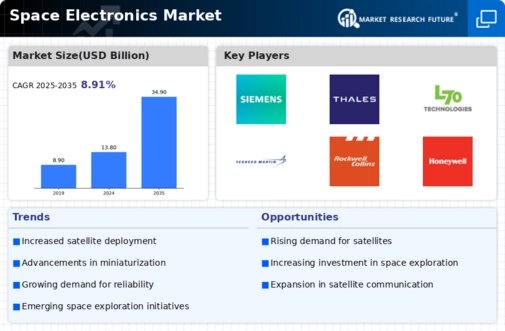Top Industry Leaders in the Space Electronics Market

Strategies Adopted: Key players in the Space Electronics Market employ various strategies to maintain their competitive edge and capitalize on market opportunities. These strategies include:
Technological Innovation: Companies invest heavily in research and development to develop advanced electronic components and systems tailored to the demanding requirements of space missions, such as radiation tolerance, temperature extremes, and reliability in harsh environments.
Strategic Partnerships and Collaborations: Collaborations with space agencies, aerospace contractors, and technology partners help companies access new markets, expand their product portfolio, and stay abreast of emerging trends and technologies.
Focus on Customization and Integration: Companies offer customizable solutions tailored to the specific requirements of space missions, including integration with satellite platforms, spacecraft subsystems, and scientific instruments, to enhance performance and mission success.
Global Expansion: Key players focus on expanding their geographical footprint by establishing subsidiaries, manufacturing facilities, and service centers in strategic locations to better serve their customers and capitalize on regional opportunities.
Key Players::
BAE Systems PLC (UK)
Microsemi Corporation (US)
Texas Instruments (US)
Xilinx Inc. (US)
Cobham PLC (UK)
TT Electronics PLC (UK)
Teledyne e2v (UK)
Heico Corporation (US)
Honeywell International Inc. (US)
ON Semiconductor (US)
ST Microelectronics NV (Switzerland)
Factors for Market Share Analysis: Several factors contribute to the analysis of market share in the Space Electronics Market, including:
Product Performance and Reliability: The performance, reliability, and durability of electronic components and systems play a critical role in determining market share, with companies offering high-quality, mission-critical solutions gaining a competitive advantage.
Technological Differentiation: Companies that differentiate themselves through technological innovation, such as miniaturization, high-speed data processing, and power efficiency, often capture a larger market share by meeting the evolving needs of space customers.
Customer Relationships: Strong relationships with space agencies, satellite operators, and prime contractors enhance market share by fostering trust, loyalty, and long-term partnerships, leading to repeat business and referrals.
Regulatory Compliance: Compliance with stringent space standards, specifications, and regulations, such as NASA-STD-8739 and MIL-STD-1540, is essential for gaining market share and securing contracts in the aerospace sector.
New and Emerging Companies: In addition to established players, new and emerging companies are entering the Space Electronics Market, bringing innovative technologies and solutions. These companies often focus on niche segments or disruptive technologies, challenging traditional players and driving innovation in the industry. Some notable new and emerging companies in the market include:
Sierra Nevada Corporation
OneWeb
Rocket Lab
Blue Origin
Spire Global
Swarm Technologies
Industry News and Current Company Investment Trends: Recent developments and investment trends in the Space Electronics Market reflect a growing focus on technological advancement, affordability, and sustainability. Key highlights include:
Advancements in Small Satellite Technology: Companies are investing in small satellite technology, such as CubeSats and SmallSats, to reduce launch costs, increase mission frequency, and enable new applications, such as Earth observation, communication, and remote sensing.
Development of Reusable Launch Vehicles: Companies are developing reusable launch vehicles, such as SpaceX's Falcon 9 and Blue Origin's New Shepard, to reduce the cost of access to space and enable frequent, affordable space missions.
Emphasis on Green Propulsion Systems: Companies are exploring green propulsion systems, such as electric propulsion and green propellants, to reduce the environmental impact of space missions and comply with sustainability goals and regulations.
Focus on Commercial Space Exploration: Companies are expanding their presence in the commercial space exploration market, partnering with private space companies and startups to develop innovative solutions for lunar exploration, asteroid mining, and space tourism.
Overall Competitive Scenario: The Space Electronics Market is highly competitive, characterized by technological innovation, strategic partnerships, and regulatory compliance. Established players leverage their experience, expertise, and global presence to maintain market leadership, while new entrants disrupt the market with innovative solutions and agile strategies. As the industry continues to evolve, companies that focus on technological differentiation, customer-centricity, and affordability will thrive in the competitive landscape of the Space Electronics Market.
Market Development
In April 2018, TT Electronics, a worldwide supplier of designed gadgets to execute basic applications, has presented its New Space Electronics range. TT Electronics' New Space Electronics® offers an answer that conveys diminished screening, and it is completely detectable with demonstrated space-grade legacy.
In September 2018, TT Electronics presented the WDBR-UL series of super-low profile high force resistors, a thick film plan. It is created on the current WDBR item. The new series' creepage, clearances, and force appraisals have been evaluated by the requests of UL508, facilitating the consistency trouble for UL endorsed end clients.


